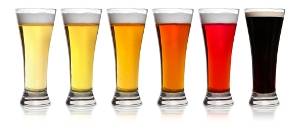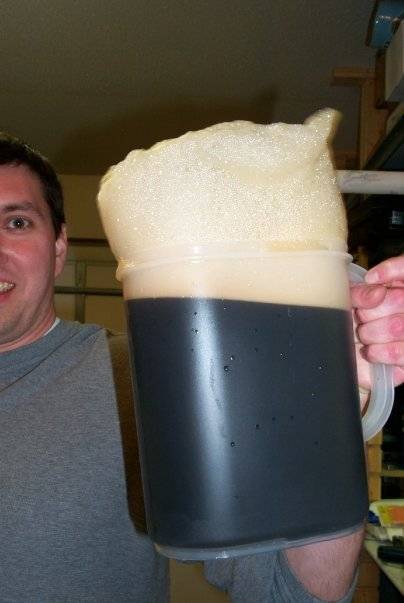
In the first two parts of this series, I looked at how different things in beer affect our senses of smell and taste. In this final part, I’ll examine how a beer can play with two of our other senses: sight and touch.
Humans are very visual creatures, so it is no wonder that the appearance of a beer is so very important. On a hot summer’s day, one might prefer a crystal clear, straw-colored pilsner with a crisp, bubbly effervescence over a dark, richly opaque and chewy barleywine. But in the dead of winter, the desires are often reversed. Why is this? What do our eyes tell us about a beer?
Well, first, we can determine color. Brewers have a couple of standard scales by which beer color is measured. The first such scale was developed by J.W. Lovibond in 1800s and bears his name. The Lovibond Scale basically compared beer color to colored glass. Then, with the advent of the spectrophotometer came two new ways of measuring beer color: the Standard Reference Method (SRM) and the European Brewing Convention (EBC). Not only are these scales used to measure beer color, but also barley malt color.
 Since beer is made with various ratios of base malts and specially kilned or roasted malts, brewers can predict what color the finished beer will be based on their recipe. A typical recipe will call for 80 to 90% of the lightest-colored base malt, with the remainder being the specialty malts. As one might imagine, the more malt in the beer, the darker the beer. This is true to a certain extent. However, a little of the dark roast malt can go a very long way in terms of color development. These two factors lead to often-confused and inaccurate assumptions about beer.mMost people tend to equate a dark color with being thick and chewy, strong in alcohol, and difficult to drink. This may be true if you compare a pale ale and a barleywine, since their malt proportions are generally somewhat similar. But if you look at something like a Guinness stout, which many often refer to as a thick beer, you might be surprised to find that it is actually a fairly light (in weight) beer, but uses some of the darkest roasted barley. (Pictured above is a stout that I brewed that displays extreme head retention.)
Since beer is made with various ratios of base malts and specially kilned or roasted malts, brewers can predict what color the finished beer will be based on their recipe. A typical recipe will call for 80 to 90% of the lightest-colored base malt, with the remainder being the specialty malts. As one might imagine, the more malt in the beer, the darker the beer. This is true to a certain extent. However, a little of the dark roast malt can go a very long way in terms of color development. These two factors lead to often-confused and inaccurate assumptions about beer.mMost people tend to equate a dark color with being thick and chewy, strong in alcohol, and difficult to drink. This may be true if you compare a pale ale and a barleywine, since their malt proportions are generally somewhat similar. But if you look at something like a Guinness stout, which many often refer to as a thick beer, you might be surprised to find that it is actually a fairly light (in weight) beer, but uses some of the darkest roasted barley. (Pictured above is a stout that I brewed that displays extreme head retention.)
This might be a good time to talk about beer “weight.” As mentioned before, a brewer can make a beer with a little barley or a lot of barley. The more they utilize, the “heavier” the beer is when compared to pure water. The terms “heavy” and “light” (or “big” and “small,” or “high” and “low” gravity) are often interchanged. A beer is measured twice, at least, during its creation. Most notably, this happens at the beginning and at the end of fermentation. Brewers use the terms “original” gravity for the beginning measurement, and “final” or “residual” for the end measurement. A high gravity beer means that the beer started with a lot of malt sugar in it. Depending on the yeast variety used and a multitude of other mitigating factors, a certain percentage of the sugars will be converted to alcohol and carbon dioxide during fermentation process. If a beer finishes high, meaning there is still a lot of sugar left, the beer will taste malty or sweet. A beer that finished with a low residual gravity will be relatively dryer. So, in playing a round with a few scenarios, a beer that starts at a high gravity and finishes low will have a lot of alcohol and be drier than one that finishes heavier. The heaviness equates to how malty the beer is in its finished form. Examples of these two scenarios might be a Belgian Tripel and a Strong Scottish Ale. Smaller or lighter beers just don’t have as much sugar in them to begin with, so there is less potential for alcohol.
Beers, like precious stones, are also evaluated by their clarity. An American light lager will be brilliantly clear; holding one up to the light is like looking through yellow-tinted sunglasses. On the other end of the spectrum, a barleywine can be darker and more opaque that the mighty Mississippi River. Beer judges can often be observed holding a flashlight up to the side of a beer as they look for rays in order to determine just how clear a beer is.
Clarity is mostly a function of protein management and yeast selection. Proteins combine with carbonation to provide head retention. Recalling that carbonation helps lift up the aromatics, we can get some prelude to the beer’s mouth-feel from across the room. Maybe this is why my mouth inherently waters when I see a beer.
The M-word, mouth-feel, is a term that is a culmination of many factors in a finished beer. It is certainly not one of linear measure. Protein, malt sugars, hops, alcohol, carbonation, esters, phenols, diacetyl, temperature, pH, and viscosity all weigh in, but the list goes on. In fact, there are so many things that have a bearing on mouth-feel that judges often disagree on what mouth-feel is a measure of, let alone how to quantify it. But nonetheless it is a major factor in evaluating a beer. Beers can be light and smooth, sparkling, tart, roasty, resiny, acidic, creamy, cloying, etc. And all of these are combinations of the above mentioned attributes. So next time you partake in your favorite brew, ask yourself not only how does it look, smell, and taste, but also how does it feel.








